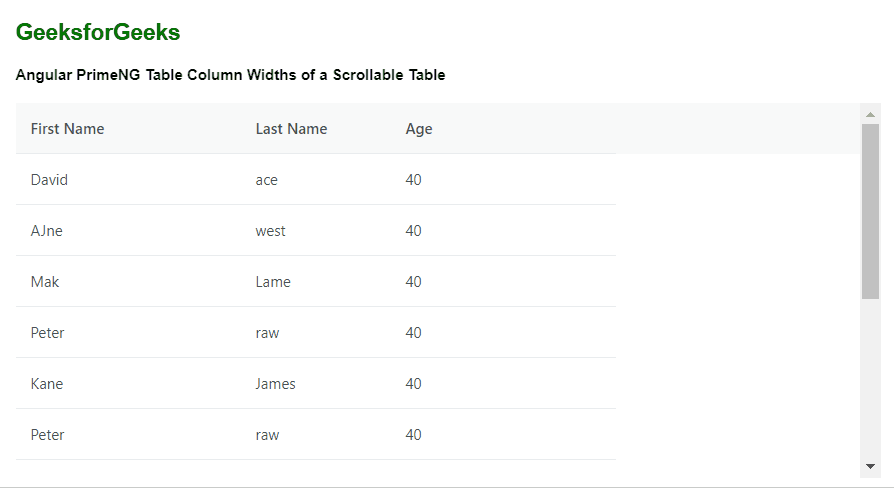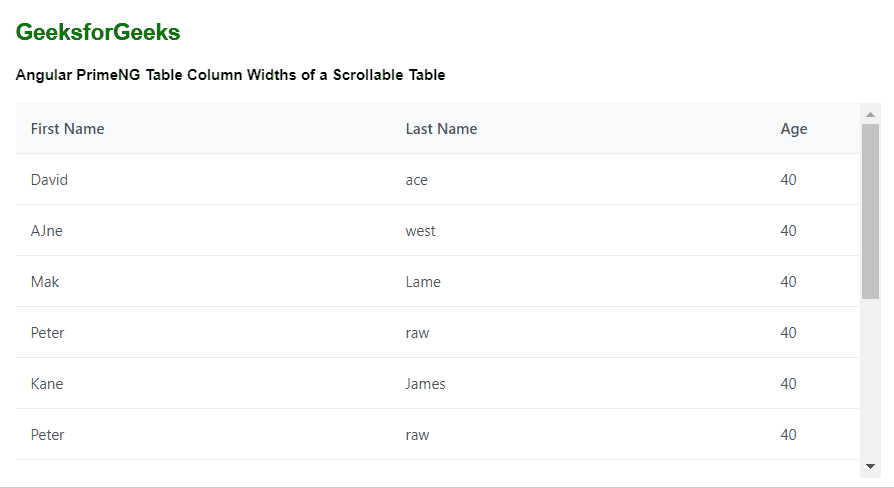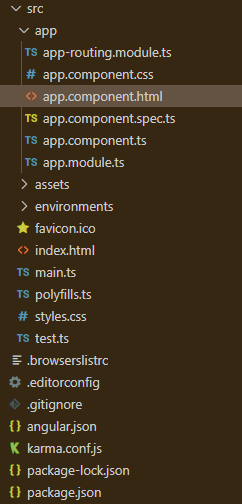Angular PrimeNG表可滚动表的列宽
Angular PrimeNG是一个开源框架,拥有丰富的原生Angular UI组件,可用于出色的造型,这个框架可用于制作响应式网站,非常方便。本文将告诉我们如何在Angular PrimeNG中使用可滚动表的表列宽度。
Angular PrimeNG Table Column Widths of a Scrollable Table是用来设置可滚动的Table组件的列宽。它使表组件在不同屏幕尺寸的设备上更具互动性和响应性。当表格处于可滚动模式时,它使用弹性布局,所以在设置表格的列宽时,有一些要点需要记住。这些要点列在下面。
- 当表格处于仅垂直滚动模式时,使用min-width属性,以便在更大的屏幕上有更多可用空间时,列可以自行调整,而在更小的屏幕上,为了响应,将显示水平滚动条。
- 在水平滚动的情况下,使用
width属性而不是min-width。 - 当仅在垂直滚动模式下,使用flex属性禁用增长和收缩,而在水平滚动模式下则不需要这样做,因为在水平滚动模式下列不会增长或收缩。
语法:
<p-table>
<ng-template pTemplate="body">
<tr>
<td style="flex: 0 0 15rem">
...
</td>
<td style="flex: 0 0 10rem">
...
</td>
<td style="flex: 0 0 15rem">
...
</td>
</tr>
</ng-template>
</p-table>
创建Angular应用程序和模块安装。
第1步:使用以下命令创建一个Angular应用程序。
ng new appname
第2步:创建你的项目文件夹即appname后,使用以下命令移动到它。
cd appname
第3步在你给定的目录中安装PrimeNG。
npm install primeng --save
npm install primeicons --save
项目结构:它将看起来像如下。
Project Structure
例子1:下面是一个简单的例子,演示了可滚动表的Angular PrimeNG表列宽度的使用。这里我们使用CSS的flex属性来设置列的宽度。
<h2 style="color: green">GeeksforGeeks</h2>
<h4>
Angular PrimeNG Table Column
Widths of a Scrollable Table
</h4>
<p-table [value]="tableData"
[scrollable]="true"
scrollHeight="400px">
<ng-template pTemplate="header">
<tr>
<th style="flex: 0 0 15rem">
First Name
</th>
<th style="flex: 0 0 10rem">
Last Name
</th>
<th style="flex: 0 0 15rem">
Age
</th>
</tr>
</ng-template>
<ng-template pTemplate="body" let-people>
<tr>
<td style="flex: 0 0 15rem">
{{ people.firstname }}
</td>
<td style="flex: 0 0 10rem">
{{ people.lastname }}
</td>
<td style="flex: 0 0 15rem">
{{ people.age }}
</td>
</tr>
</ng-template>
</p-table>
import { Component } from '@angular/core';
interface People {
firstname?: string;
lastname?: string;
age?: string;
}
@Component({
selector: 'app-root',
templateUrl: './app.component.html',
})
export class AppComponent {
tableData: People[] = [];
cols: any[] = [];
constructor() { }
ngOnInit() {
this.cols = [
{ field: 'firstname', header: 'First Name' },
{ field: 'lastname', header: 'Last Name' },
{ field: 'age', header: 'Age' },
];
this.tableData = [
{
firstname: 'David',
lastname: 'ace',
age: '40',
},
{
firstname: 'AJne',
lastname: 'west',
age: '40',
},
{
firstname: 'Mak',
lastname: 'Lame',
age: '40',
},
{
firstname: 'Peter',
lastname: 'raw',
age: '40',
},
{
firstname: 'Kane',
lastname: 'James',
age: '40',
},
{
firstname: 'Peter',
lastname: 'raw',
age: '40',
},
{
firstname: 'Kane',
lastname: 'James',
age: '40',
},
{
firstname: 'Peter',
lastname: 'raw',
age: '40',
},
{
firstname: 'Kane',
lastname: 'James',
age: '40',
},
{
firstname: 'Peter',
lastname: 'raw',
age: '40',
},
{
firstname: 'Kane',
lastname: 'James',
age: '40',
},
{
firstname: 'Peter',
lastname: 'raw',
age: '40',
},
{
firstname: 'Kane',
lastname: 'James',
age: '40',
},
];
}
}
import { NgModule } from '@angular/core';
import { BrowserModule } from '@angular/platform-browser';
import { FormsModule } from '@angular/forms';
import { BrowserAnimationsModule }
from '@angular/platform-browser/animations';
import { AppComponent } from './app.component';
import { TableModule } from 'primeng/table';
@NgModule({
imports: [
BrowserModule,
BrowserAnimationsModule,
TableModule,
FormsModule
],
declarations: [AppComponent],
bootstrap: [AppComponent],
})
export class AppModule { }
输出:

例子2:下面是另一个例子,演示了可滚动表的Angular PrimeNG表列宽度的使用。在这里,我们使用max-width 属性来设置表列的宽度。
<h2 style="color: green">GeeksforGeeks</h2>
<h4>
Angular PrimeNG Table Column
Widths of a Scrollable Table
</h4>
<p-table [value]="tableData"
[scrollable]="true"
scrollHeight="400px">
<ng-template pTemplate="header">
<tr>
<th style="max-width:400px">
First Name
</th>
<th style="max-width:400px">
Last Name
</th>
<th style="max-width:100px">
Age
</th>
</tr>
</ng-template>
<ng-template pTemplate="body" let-people>
<tr>
<td style="max-width:400px">
{{ people.firstname }}
</td>
<td style="max-width:400px">
{{ people.lastname }}
</td>
<td style="max-width:100px">
{{ people.age }}
</td>
</tr>
</ng-template>
</p-table>
import { Component } from '@angular/core';
interface People {
firstname?: string;
lastname?: string;
age?: string;
}
@Component({
selector: 'app-root',
templateUrl: './app.component.html',
})
export class AppComponent {
tableData: People[] = [];
cols: any[] = [];
constructor() { }
ngOnInit() {
this.cols = [
{ field: 'firstname', header: 'First Name' },
{ field: 'lastname', header: 'Last Name' },
{ field: 'age', header: 'Age' },
];
this.tableData = [
{
firstname: 'David',
lastname: 'ace',
age: '40',
},
{
firstname: 'AJne',
lastname: 'west',
age: '40',
},
{
firstname: 'Mak',
lastname: 'Lame',
age: '40',
},
{
firstname: 'Peter',
lastname: 'raw',
age: '40',
},
{
firstname: 'Kane',
lastname: 'James',
age: '40',
},
{
firstname: 'Peter',
lastname: 'raw',
age: '40',
},
{
firstname: 'Kane',
lastname: 'James',
age: '40',
},
{
firstname: 'Peter',
lastname: 'raw',
age: '40',
},
{
firstname: 'Kane',
lastname: 'James',
age: '40',
},
{
firstname: 'Peter',
lastname: 'raw',
age: '40',
},
{
firstname: 'Kane',
lastname: 'James',
age: '40',
},
{
firstname: 'Peter',
lastname: 'raw',
age: '40',
},
{
firstname: 'Kane',
lastname: 'James',
age: '40',
},
];
}
}
import { NgModule } from '@angular/core';
import { BrowserModule } from '@angular/platform-browser';
import { FormsModule } from '@angular/forms';
import { BrowserAnimationsModule }
from '@angular/platform-browser/animations';
import { AppComponent } from './app.component';
import { TableModule } from 'primeng/table';
@NgModule({
imports: [
BrowserModule,
BrowserAnimationsModule,
TableModule,
FormsModule
],
declarations: [AppComponent],
bootstrap: [AppComponent],
})
export class AppModule { }
输出:

 极客教程
极客教程